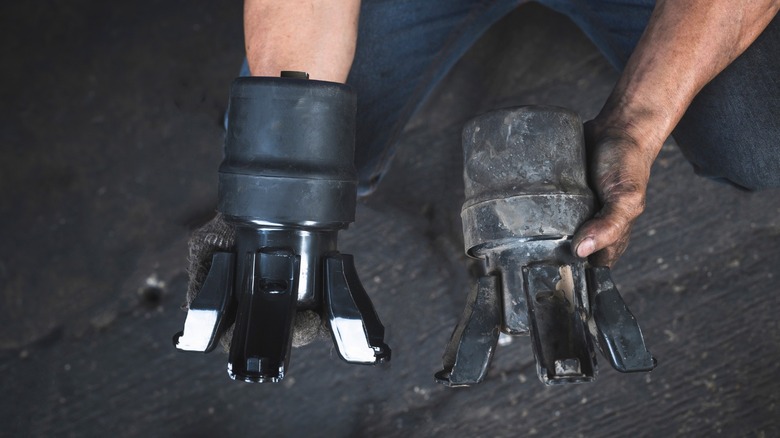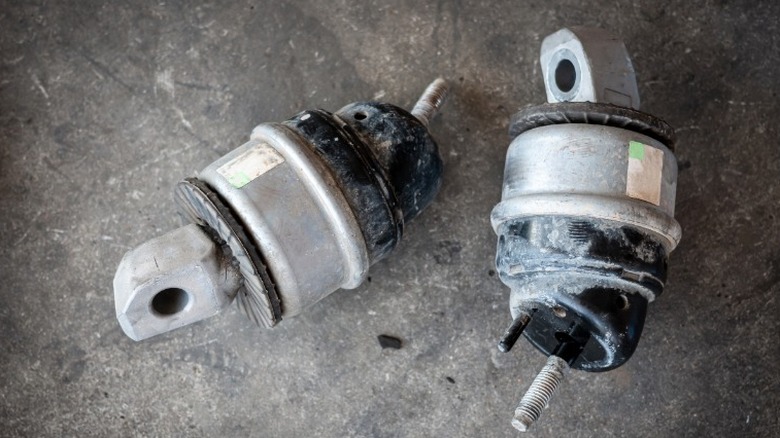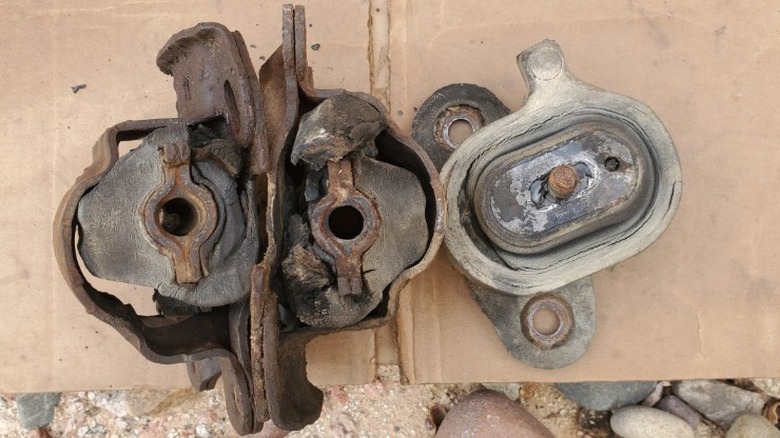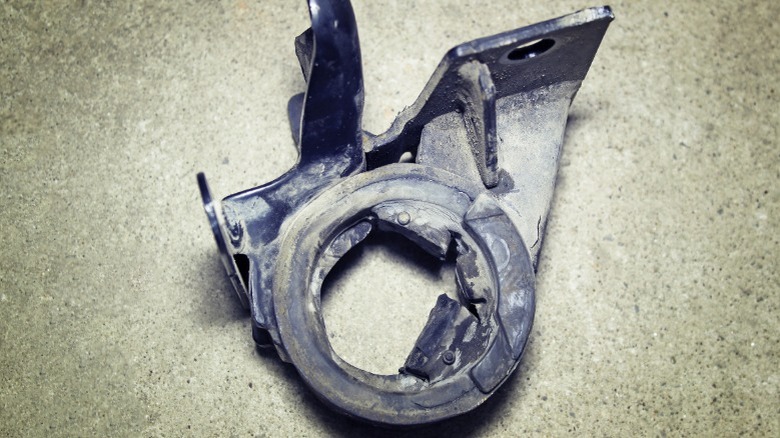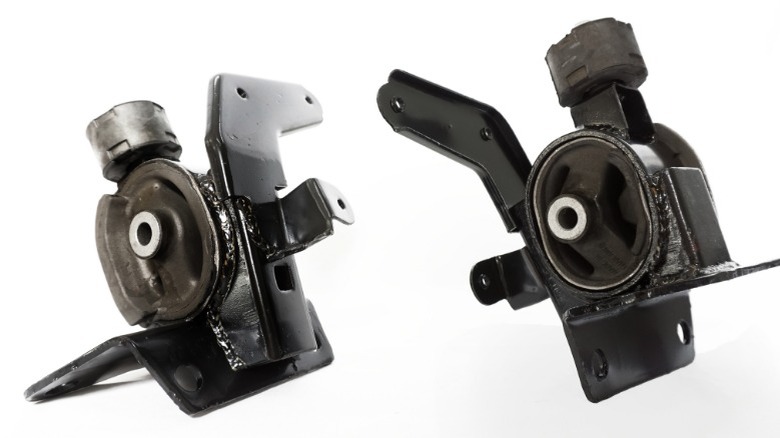How Many Engine Mounts Does A Car Have And How Long Do They Last?
The engines that power our cars — even the smallest ones — are extremely heavy. While smaller engines like four-cylinders and V6s can weigh between 200 and 450 pounds, larger motors like heavy-duty diesels and V8s can weigh up to 700 pounds. That's a lot of weight, not only for your car to carry while it's sitting stationary, but especially when you're driving down the road navigating various bumps and curves and the internal pistons are pounding up and down. Basically, your engine bounces around a lot during normal operation, which is why it's not just welded to the vehicle's frame.
Instead, our engines rely on special components known as engine or motor mounts to hold them in place. These parts use rubber bushings to enable the natural movement of the engine as we drive and as the mechanical parts inside the motor move around at incredibly high speeds. They allow for this movement without letting the engine bounce into other components or break free.
Depending on your vehicle and its engine, your car most likely has between two and four motor mounts. They're commonly found located at the sides and backs of the engine bay, and they often look like large circular metal brackets with thick rubber bushings. If you're curious about learning more about motor mounts, how to determine the number of motor mounts your car has, and how long they last, we've got you covered. As a former professional auto repair technician and a lifelong car nerd, I'll break it down for you. Here's everything you need about engine mounts.
How to know how many motor mounts your car has
If you're curious about how many engine mounts your car has, there are a couple of methods you can use to find the information. For mechanically-inclined people with some basic car knowledge, popping the hood and looking for yourself is a quick and easy way to count your engine mounts. As mentioned above, motor mounts are typically located toward the back and sides of the motor and connect to the car's frame.
If you aren't an experienced car person, the engine bay may seem like a confusing and chaotic puzzle, and it may be incredibly challenging for you to identify your motor mounts. Instead of trying to locate the engine mounts yourself, you can look the information up online. For popular makes and models, it's relatively easy to find information on forums and various other websites. Alternatively, you can search for engine diagrams that include part numbers. These types of graphics are commonly found on the websites of automakers' parts departments, and the part numbers will help you identify individual mounts and their locations. If all of that fails, you can search for a model-specific repair manual, like those published by Haynes or Chilton. These books usually contain detailed diagrams, maintenance info, and repair steps for DIYers and home mechanics, and they can be a wonderful source of information for anyone interested in learning more about their car.
Finally, you can always ask your local mechanic to count the mounts for you. A trained technician will be able to identify each of your car's motor mounts with ease, and they should only take a second to do so. However, keep in mind that if you visit a pro for this service, you'll most likely have to pay a fee of some kind.
The lifespan of a car's engine mounts depends on several factors
Motor mounts are heavy-duty, durable components designed to last for thousands of miles. However, engine mounts aren't indestructible, and they are subject to wear and tear over time. While it's possible for some types of motor mounts to last for your vehicle's entire lifetime, they also may fail at some point and need to be replaced. Generally, most rubber motor mounts last for at least five to seven years before they wear out, while other types may last for more or less time depending on the materials and applications.
In addition to the type of motor mount and its materials, a few other factors can affect the lifespan of your vehicle's engine mounts. One of the most critical factors is the way you maintain and care for your car. If you live in an area with severe winters, and you rarely visit the car wash or the mechanic for routine maintenance, your motor mounts may fail earlier. On the other hand, if you live in a moderate climate and care for your car meticulously, you can generally expect your motor mounts to last for a longer time.
Your driving style and your engine will also have an impact on the lifespan of the motor mounts. If you hot rod your car around town or modify it heavily, the mounts may experience extra stress and wear out earlier. There's no way to guarantee that your motor mounts will last forever, but one of the best ways to ensure that they remain in good condition for as long as possible is to drive sensibly, modify your car with caution, and keep up with routine maintenance.
What are the signs of failing engine mounts?
While motor mounts are extremely durable and generally last for long periods of time, they can fail. If all of your mounts fail completely, you're likely to experience severe engine damage and highly expensive repair costs. Don't worry, though — it's relatively rare for all of your motor mounts to fail at the same time. Furthermore, worn-out engine mounts typically display a few symptoms. If you recognize these signs, you can address the issue before your car develops more serious damage.
One of the most obvious signs of failing motor mounts is visible physical damage to the mounts, which may appear as cracked bushings or bent brackets. Another common sign of worn-out engine mounts is excessive clunking or vibrations coming from the engine bay. The mounts stabilize the motor and hold it in place. However, if they're worn out, your engine may move around a lot more, resulting in vibrations, clunking noises, and thudding sounds.
If the mounts become sufficiently worn-out, your engine may move and bounce around so much that it develops internal and external damage. Excessive movement and vibrations can break or otherwise damage sensitive internal parts or cause external components like belts, hoses, and pulleys to fail, break, or disconnect from the motor. If you notice any signs of motor mount damage, including strange lurches, bumps, clunking sounds, physical damage, or random mechanical problems, you should visit a mechanic as soon as possible for an inspection and diagnosis.
How to inspect your motor mounts
Keeping an eye out for the signs of failing motor mounts is always a wise idea, but it's also smart to inspect the mounts every so often to ensure that they're in solid condition. Fortunately, it's relatively easy to inspect your mounts for damage and wear. There are three primary ways to check your motor mounts, and only one of those methods requires the use of a tool.
The first and easiest way to check your engine mounts is to inspect them visually. You should look for signs of damage, like cracked, warped, or split bushings, as well as things like damage to the mount's bracket and spilled fluids. Brake fluid, in particular, can be extremely harmful to rubber components like motor mounts. If you notice signs of damage to the bushings or brackets, or external threats like fluid leaks, you should visit a mechanic or address the problem yourself as soon as possible.
The second way to check your motor mounts is by using a pry bar. This method requires you to place one end of the pry bar between the motor mount's bracket and the bushing and push. A little movement is normal. However, if the mount moves excessively, or you can see cracks and splits in the rubber when you apply force, you likely need to replace the mount.
The final way to inspect your motor is sometimes known as power braking and requires a helper. For this method, you'll need a friend to put the car in drive and lightly rev the engine while holding the brake pedal. Your friend should do this in drive and in reverse while you stand outside observing the engine. If the motor moves or lurches excessively during this test, your mounts are bad.
